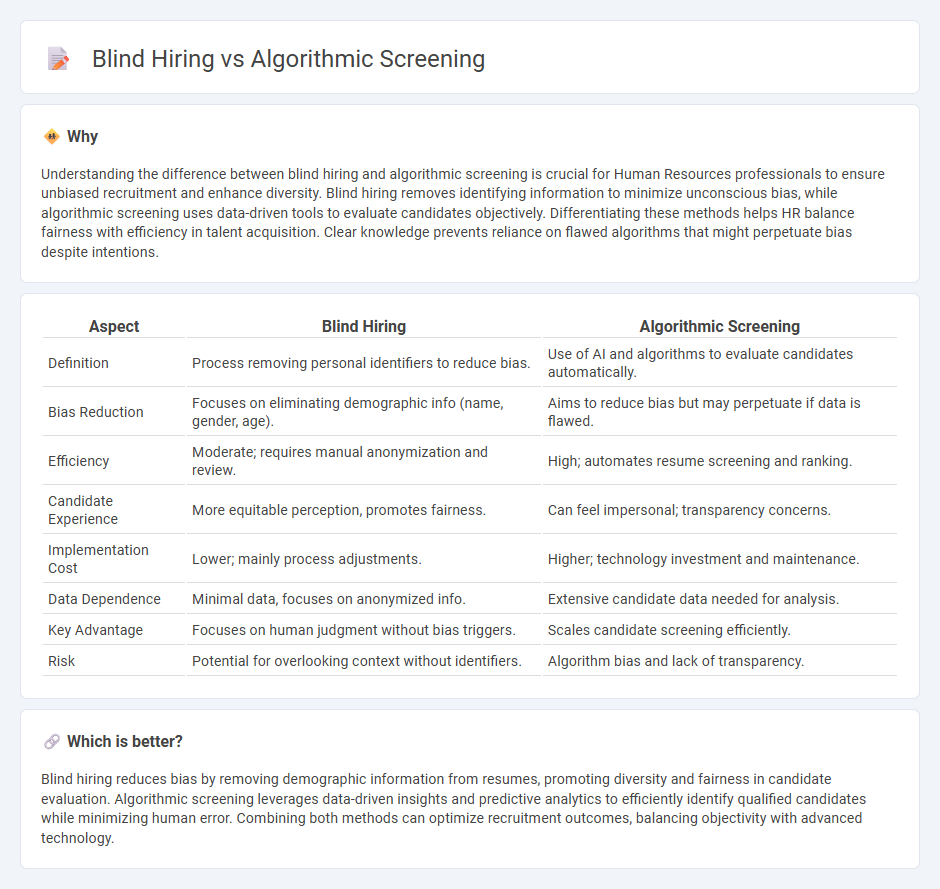
Blind hiring eliminates biases by removing personal information from resumes, focusing solely on candidates' skills and qualifications. Algorithmic screening leverages artificial intelligence to analyze large volumes of applications, enhancing efficiency and consistency in candidate evaluation. Explore more to understand how these approaches transform recruitment processes.
Why it is important
Understanding the difference between blind hiring and algorithmic screening is crucial for Human Resources professionals to ensure unbiased recruitment and enhance diversity. Blind hiring removes identifying information to minimize unconscious bias, while algorithmic screening uses data-driven tools to evaluate candidates objectively. Differentiating these methods helps HR balance fairness with efficiency in talent acquisition. Clear knowledge prevents reliance on flawed algorithms that might perpetuate bias despite intentions.
Comparison Table
| Aspect | Blind Hiring | Algorithmic Screening |
|---|---|---|
| Definition | Process removing personal identifiers to reduce bias. | Use of AI and algorithms to evaluate candidates automatically. |
| Bias Reduction | Focuses on eliminating demographic info (name, gender, age). | Aims to reduce bias but may perpetuate if data is flawed. |
| Efficiency | Moderate; requires manual anonymization and review. | High; automates resume screening and ranking. |
| Candidate Experience | More equitable perception, promotes fairness. | Can feel impersonal; transparency concerns. |
| Implementation Cost | Lower; mainly process adjustments. | Higher; technology investment and maintenance. |
| Data Dependence | Minimal data, focuses on anonymized info. | Extensive candidate data needed for analysis. |
| Key Advantage | Focuses on human judgment without bias triggers. | Scales candidate screening efficiently. |
| Risk | Potential for overlooking context without identifiers. | Algorithm bias and lack of transparency. |
Which is better?
Blind hiring reduces bias by removing demographic information from resumes, promoting diversity and fairness in candidate evaluation. Algorithmic screening leverages data-driven insights and predictive analytics to efficiently identify qualified candidates while minimizing human error. Combining both methods can optimize recruitment outcomes, balancing objectivity with advanced technology.
Connection
Blind hiring minimizes bias by anonymizing candidate information such as names, gender, and age, while algorithmic screening uses AI-driven tools to objectively evaluate qualifications and skills. Together, they enhance fairness and diversity in recruitment processes by focusing on merit rather than demographic factors. Companies leveraging these technologies report increased candidate quality and reduced unconscious bias in hiring decisions.
Key Terms
Bias Mitigation
Algorithmic screening utilizes data-driven models to reduce human bias by evaluating candidates based on objective criteria and patterns in large datasets, enhancing fairness in the hiring process. Blind hiring removes identifiable information such as names, gender, or ethnicity from applications to prevent unconscious bias, promoting diversity and inclusivity. Explore more to understand how these strategies impact bias mitigation and improve recruitment outcomes.
Objective Evaluation
Algorithmic screening leverages artificial intelligence and machine learning to analyze candidate data objectively, minimizing human bias during the initial hiring stages. Blind hiring removes personally identifiable information such as names, gender, and education background to ensure decisions are based solely on skills and qualifications. Explore how combining these approaches enhances fairness and efficiency in talent acquisition.
Data Privacy
Algorithmic screening automates candidate evaluation through data-driven models, raising critical concerns about data privacy and potential biases embedded in the algorithms. Blind hiring minimizes bias by anonymizing candidate information, but still requires careful management of personal data to comply with privacy regulations like GDPR and CCPA. Explore how these methods balance efficiency and privacy to optimize fair recruitment practices.
Source and External Links
Challenges for mitigating bias in algorithmic hiring - This article discusses the challenges of removing bias from algorithmic hiring tools, which often reflect and amplify existing biases found in the data used to train them.
Development and multinational validation of an algorithmic strategy - This study describes the development and validation of a machine learning model for identifying individuals with elevated levels of a specific biomarker.
Exploration-based algorithms can improve hiring quality and diversity - MIT researchers have developed an algorithmic approach that can increase diversity in hiring by exploring a broader pool of candidates beyond traditional resume screening methods.
 dowidth.com
dowidth.com